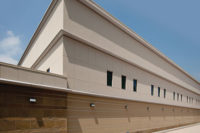A recent life-cycle inventory conducted by Franklin Associates/ERG in April 2009 shows that Sto Corp. engineered cladding systems, especially StoTherm\ NExT, outperform other wall claddings over a full 50-year product life. Comparisons with typical brick and stucco interms of production energy, heating/cooling energy, solid waste, and greenhouse-gas emissions reveal a clear advantage for insulated Stocladdings, in particular over non-insulated brick and stucco walls.
SUMMARY: A new Life-Cycle Inventory (LCI) of wall cladding products has been conducted to compare energy use andenvironmental impacts associated with several residential wall types. Three Sto Corp. cladding systems – StoThermNExT EIFS, StoPowerwallTM NExT stucco, and StoQuik SilverNExT cement-board stucco – are analyzed and compared to typical brick and stucco walls, with and without foam insulation, for a typical residential property. The LCI results demonstrate good life-cycle performance of the Sto Corp.cladding systems in terms of waste, emissions, and energy used in production, construction and building operations. In particular, StoTherm NExT claddings excel in reducing lifecycle energy use and greenhouse-gas emissions.
Key findings include:
• StoTherm NExT requires the least production energy (manufacturing phase) of the insulated claddings. In the “cradle-to-wall” phase, StoTherm NExT also requires the least energy.
• In operations, uninsulated brick and stucco consume about twice as much heating/cooling energy as StoTherm NExT.
• Over the full 50-year life cycle, energy demand is lower forStoTherm NExT than for uninsulated brick or stucco.
• All the Sto Corp. systems, including StoTherm NExT,contribute less solid waste than typical brick or stucco.
• StoTherm NExT has the lowest total greenhouse-gasemissions.
BACKGROUND ON THE LIFE-CYCLE STUDY: The primary focus of the LCI is energy use. With energy conservationbecoming a high priority for the architecture and construction industry over the past five years – and as part o fSto Corp.’s commitment to sustainable design – Sto Corp.commissioned this life-cycle study. Other key lifecycle comparisons are greenhouse gas emissions and solid waste associated with the cladding systems. All of these measures are useful in assessing the sustainability and energy efficiency of the subject wall types.
HOW THE STUDY WAS CONDUCTED: This LCI study takes into account the different manufacturing requirements and levels of thermal insulation for each cladding system. Energy use for cooling and heating is calculated for a 2,500-square-foot,wood-framed reference house using Oak Ridge National Lab’s Whole Wall R-value Calculator. With these and other measures, the life-cycle study quantifies comparative energy use (fossil and non-fossil), greenhouse-gas emissions, and solid waste related to each cladding type during the production (“cradle-to-wall”) phase and over an assumed 50-year life.
To help Sto Corp. better understand the environmental effects associated with production and use of their product,Franklin Associates analyzed these life-cycle impacts for:StoTherm® NExT exterior insulation and finish system (EIFS);Sto Powerwall™ NExT, a hard-coat stucco system; and StoQuik® Silver NExT, a cement board stucco system. Results were compared against life-cycle impacts of typical brickcladdings and stucco claddings, in both insulated and noninsulated assemblies.1
The base home walls use 2x4 wood frame construction, withstuds 16” on center, R-11 of fiberglass insulation and woods heathing. LCI RESULTS: The Sto Corp. cladding systems compared favorably to typical brick and stucco claddings,with a pronounced advantage over uninsulated brick and stucco claddings. The LCI showed that the Sto Corp.assemblies: (1) require less production energy, (2) produce lesse missions and waste, and also (3) provide superior energy performance over typical stucco and brick, especially over a50-year life cycle.
PRODUCTION ENERGY (Figure ES-1): The LCI study shows thatStoTherm NExT requires the least production energy of the insulated claddings. Typical brick cladding requires the most energy for manufacturing, even without added insulation.The StoPowerwall, StoQuik Silver and stucco cladding, made from similar materials, require comparably lower levels of energy for manufacture. But when XEPS insulation board is included, they all require more energy than the StoThermNExT cladding, which uses EPS insulation board. EPS has alower density than XEPS, so less material is used in manufacture. ·
HEATING AND COOLING ENERGY (Figures ES-2 and ES-3):StoTherm NExT EIFS is also shown to require much less energy for heating and cooling than uninsulated brick and stucco,which require the most energy during the winter and summer months. The LCI showed that annual energy used for heating and cooling is comparable for the StoTherm NExT system and the insulated brick and stucco cladding.
50-YEAR ENERGY USE (Figure ES-6): In the study, StoThermNExT is found to have the lowest energy requirement from“cradle to wall,” and very low energy use compared to uninsulated brick and stucco over the full life cycle.When put to the test for their 50-year life cycle, StoThermNExT and insulated brick and stucco claddings consume about the same amount of total energy, in the range of 800MMBtu. The StoTherm NExT enclosure has slightly higher energy requirements only for heating during the operations phase when compared to brick and stucco with XEPSinsulation. When compared to uninsulated brick and stucco, the lifecycle energy use of StoTherm NExT is significantly lower.
GREENHOUSE GASES (Figure ES-10): Greenhouse-gas emissions over the full 50-year lifecycle show a clea radvantage for StoTherm NExT, even though brick and stucco with XEPS insulation demonstrate good insulating properties.In the production or “cradle-to-wall” phase, all systems using XEPS insulation show dramatically high levels of emissions.This reflects the fact that XEPS is made with HCFC-142b, a powerful greenhouse gas. For that reason, total “cradle-to wall”greenhouse-gas emissions are lowest for StoThermNExT, which uses EPS, and uninsulated StoPowerwall NExTand StoQuik Silver NExT. Uninsulated brick and stucco show higher manufacturing emissions.
SOLID WASTE (Figure ES-11): Based on an LCI of the disposal and potential reuse of cladding materials, all of the Sto Corp.systems are shown to contribute much less solid waste than typical brick or stucco. In particular, StoPowerwall NExT and StoTherm NExT are shown to produce the least waste.
ADDITIONAL FINDINGS: The LCI also confirms these general points about energy use and sustainability: (1) Heavier cladding systems create more solid waste in production and at end-of-life; however, life-cycle calculations should consider industrial waste from fuel production, which is also significant over 50 years. (2) Greenhouse-gas emissions vary according to total energy use, except when the cladding systems use XEPSinsulation, which is made with a blowing agent, HFCF-142b, with a very high global warming potential, or GWP. (3) While energy use for cladding systems varies widely in manufacture, these variations are minimal when compared to total energy use over a 50-year life cycle. Cladding systems with exterior insulation use much less energy over the full life-cycle period because of their higher total R-value and the fact that insulation used on the exterior is far more efficient than between-the-stud insulation.
CONCLUSIONS: In the production phases and over a 50-year life cycle, StoTherm NExT and other engineered Sto Corp.cladding systems provide distinct advantages over typical brick and stucco claddings. This is true in all of the areas studied, including energy use, greenhouse gas emissions, and solid waste production. The StoTherm NExT system, especially, compares favorably in terms of life-cycle energy use and greenhouse-gas emissions, according to the LCI results.
Summary by Terry Viness, Sto Corp. Life-cycle inventory (LCI) study commissioned by Sto Corp. and conducted by Franklin Associates, a division of ERG, based in Prairie Village, Kansas. The original paper, “Life-Cycle Inventory of Wall Cladding,” is available through Sto Corp.
1 Brick assembly: 4-inch (102 mm) clay brick/mortar, 2 layers Grade D
buildingpaper; Insulated brick assembly: 4-in. clay brick/mortar, 2-in.
(51 mm)-thick
2.0pcf (32 kg/m3) extruded polystyrene rigid insulation
(XEPS), 2 layers Grade Dbuilding paper; Stucco assembly: 7/8-inch (22
mm)-thick three-coat stucco, 2.5-lb/yd2 expanded metal lath, 2 layers
building paper; Insulated stucco assembly:7/8-in.-thick three-coat
stucco, 2.5-lb/yd2 (1.36 kg/m2) expanded metal lath, 2-in. (51
mm)-thick 2.0 pcf XEPS insulation, 2 layers building paper.
Get our new eMagazine delivered to your inbox every month.
Stay in the know on the latest in the wall and ceiling industry.
SUBSCRIBE NOWCopyright ©2024. All Rights Reserved BNP Media.
Design, CMS, Hosting & Web Development :: ePublishing

![WC0422-FEAT-ClarkDietrich-p1FT-CJ-EES[1].jpg WC0422-FEAT-ClarkDietrich-p1FT-CJ-EES[1].jpg](https://www.wconline.com/ext/resources/2022/04/12/WC0422-FEAT-ClarkDietrich-p1FT-CJ-EES%5b1%5d.jpg?height=200&t=1649794590&width=200)



Report Abusive Comment